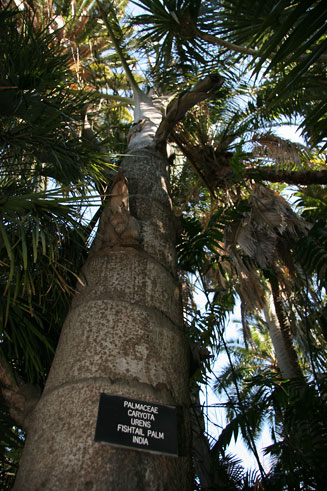|
Caryota urens (Fishtail palm)
Life
> eukaryotes >
Archaeoplastida >
Chloroplastida
>
Charophyta > Streptophytina > Plantae (land plants)
> Tracheophyta (vascular plants) > Euphyllophyta > Lignophyta (woody plants)
> Spermatophyta (seed plants) > Angiospermae (flowering
plants)
> Monocotyledons > Order: Arecales > Family: Arecaceae
> Genus: Caryota
 |
|
|
Caryota urens, Cape Town Company Gardens,
Western Cape, South Africa. [photo
H.G.
Robertson, Iziko ©] |
|
Indigenous from India eastwards to Malaysia, Indonesia and
Australia. It has bipinnate leaves (unique to palms) and the drooping clusters
of flowers up the trunk of the tree are distinctive. It has been introduced to
many countries in warm regions of the world, where it is grown mainly as an
ornamental and street tree. It is also used as a source of palm sugar: the sap
is collected from where flower clusters have been cut off. Up to 20 litres of
sugary sap can be collected per tree per day. The sap is also
fermented to produce palm wine or toddy, which when distilled, produces the
spirit termed 'arrack'. These products are also produced from other palm
species.
Links
Publications
-
van Wyk, B.-E. 2005. Food Plants of the World -
Identification, Culinary Uses and Nutritional Value. Briza, Pretoria.
|
